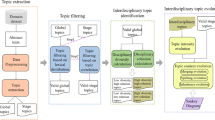Abstract
Collaboration platforms provide a dynamic environment where the content is subject to ongoing evolution through expert contributions. The knowledge embedded in such platforms is not static as it evolves through incremental refinements – or micro-contributions. Such refinements provide vast resources of tacit knowledge and experience. In our previous work, we proposed and evaluated a Semantic and Time-dependent Expertise Profiling (STEP) approach for capturing expertise from micro-contributions. In this paper we extend our investigation to structured micro-contributions that emerge from an ontology engineering environment, such as the one built for developing the International Classification of Diseases (ICD) revision 11. We take advantage of the semantically related nature of these structured micro-contributions to showcase two major aspects: (i) a novel semantic similarity metric, in addition to an approach for creating bottom-up baseline expertise profiles using expertise centroids; and (ii) the application of STEP in this new environment combined with the use of the same semantic similarity measure to both compare STEP against baseline profiles, as well as to investigate the coverage of these baseline profiles by STEP.








Similar content being viewed by others
References
Balog, K. (2008). People search in the enterprise. Ph.D. thesis, University of Amsterdam.
Biomed Experts (2014). http://www.biomedexperts.com/. Accessed 17 September 2014.
Bizer, C., Heath, T., & Berners-Lee, T. (2009). Linked data – the story so far. International Journal on Semantic Web and Information Systems, 5(3), 1–22.
Chodorow, M., & Leacock, C. (1997). Combining local context and WordNet similarity for word sense identification. Fellbaum, 265–283.
Groza, T., & Tudorache, T. (2013). Dumontier, M.: State of the art and open challenges in community-driven knowledge curation. Journal of Biomedical Informatics, 46(1), 1–4.
Jonquet, C., Shah, N.H., & Musen, M.A. (2009). The open biomedical annotator. Summit on translational bioinformatics, 2009, 56–60.
Möller, K., Heath, T., Handschuh, S., & Domingue, J. (2007). Recipes for semantic web dog food: The ESWC and ISWC metadata projects. In Proceedings of the 6th International Semantic Web Conference (pp. 802–815). Springer.
Monaghan, F., Bordea, G., Samp, K., & Buitelaar, P. (2010). Exploring your research: Sprinkling some saffron on semantic web dog food. In Proceedings of the semantic web challenge at the international semantic web conference.
Noy, N.F., Chugh, A., Liu, W., & Musen, M.A. (2006). A framework for ontology evolution in collaborative environments. In Proceedings of the 5th international semantic web conference (pp. 544–558). Springer.
Pesquita, C., Faria, D., Falcao, A., Lord, P., & Couto, F. (2009). Semantic similarity in biomedical ontologies. PLoS Computational Biology, 5(7).
Price, S., Flach, P.A., Spiegler, S., Bailey, C., & Rogers, N. (2013). SubSift web services and workflows for profiling and comparing scientists and their published works. Future Generation Computer Systems, 29(2), 569–581.
Professional Networking and Expertise Mining for Research Collaboration (2014). http://profiles.catalyst.harvard.edu/. Accessed 17 September 2014.
Pure (2014). http://info.scival.com/pure. Accessed 17 September 2014.
Rada, R., Mili, H., Bicknell, E., & Blettner, M. (1989). Development and application of a metric on semantic nets. IEEE Transactions on Systems, Man and Cybernetics, 19(1), 17–30.
Resnik, P. (1995). Using information content to evaluate semantic similarity in a taxonomy. In Proceedings of the 14th IJCAI (pp. 448–453).
ResearchGate (2014). http://www.researchgate.net/. Accessed 17 September 2014.
Sánchez, D., & Batet, M. (2011). Semantic similarity estimation in the biomedical domain: An ontology-based information-theoretic perspective. Journal of biomedical informatics, 44(5), 749–759.
Seco, N., Veale, T., & Hayes, J. (2004). An intrinsic information content measure for semantic similarity in WordNet. In Proceedings of ECAI 2004 (pp. 1089–1090).
Stack Overflow (2014). http://stackoverflow.com/. Accessed 17 September 2014.
Tudorache, T., Nyulas, C., Noy, N.F., & Musen, M.A. (2013a). Using semantic web in ICD-11: three years down the road. In Proceedings of the 12th international semantic web conference (pp. 195–211). Springer.
Tudorache, T., Nyulas, C., Noy, N.F., & Musen, M.A. (2013b). WebProtégé: A collaborative ontology editor and knowledge acquisition tool for the Web. Semantic Web Journal, 4(1), 89–99.
Wikipedia: WikiProject Genetics (2014). http://en.wikipedia.org/wiki/Wikipedia:WikiProject_Genetics. Accessed 17 September 2014.
Wikipedia: WikiProject Medicine (2014). http://en.wikipedia.org/wiki/Wikipedia:WikiProject_Medicine. Accessed 17 September 2014.
Wikipedia: WikiProject Molecular and Cellular Biology (2014). http://en.wikipedia.org/wiki/Wikipedia:MCB. Accessed 17 September 2014.
World Health Organization (2014). International Classification of Diseases. http://www.who.int/classifications/icd/en/. Accessed 17 September 2014.
Wu, Z., & Palmer, M. (1994). Verb semantics and lexicon selection. In Proceedings of the 32nd ACL (pp. 133–138).
Zhou, Z., Wang, Y., & Gu, J. (2008). A new model of information content for semantic similarity in WordNet. In Proceedings of the 2nd international conference on future generation communication and networking symposia, (Vol. 3 pp. 85–89). IEEE.
Ziaimatin, H., Groza, T., Bordea, G., Buitelaar, P., & Hunter, J. (2012). Expertise profiling in evolving knowledge-curation platforms. GSTF Journal on Computing, 2(3), 118–128.
Ziaimatin, H., Groza, T., & Hunter, J. (2013). Semantic and time-dependent expertise profiling models in community-driven knowledge curation platforms. Future Internet, 5(4), 490–514.
Acknowledgments
This research is partly funded by the Australian Research Council (ARC) Discovery Early Career Researcher Award (DECRA) – DE120100508.
Author information
Authors and Affiliations
Corresponding author
Rights and permissions
About this article
Cite this article
Ziaimatin, H., Groza, T., Tudorache, T. et al. Modelling expertise at different levels of granularity using semantic similarity measures in the context of collaborative knowledge-curation platforms. J Intell Inf Syst 47, 469–490 (2016). https://doi.org/10.1007/s10844-015-0376-1
Received:
Accepted:
Published:
Issue Date:
DOI: https://doi.org/10.1007/s10844-015-0376-1




